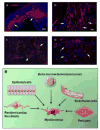Mechanisms of Fibroblast Activation in the Remodeling Myocardium
- PMID: 29057165
- PMCID: PMC5646705
- DOI: 10.1007/s40139-017-0132-z
Mechanisms of Fibroblast Activation in the Remodeling Myocardium
Abstract
Purpose of review: Activated fibroblasts are critically implicated in repair and remodeling of the injured heart. This manuscript discusses recent progress in the cell biology of fibroblasts in the infarcted and remodeling myocardium, highlighting advances in understanding the origin, function and mechanisms of activation of these cells.
Recent findings: Following myocardial injury, fibroblasts undergo activation and myofibroblast transdifferentiation. Recently published studies have suggested that most activated myofibroblasts in the infarcted and pressure-overloaded hearts are derived from resident fibroblast populations. In the healing infarct, fibroblasts undergo dynamic phenotypic alterations in response to changes in the cytokine milieu and in the composition of the extracellular matrix. Fibroblasts do not simply serve as matrix-producing cells, but may also regulate inflammation, modulate cardiomyocyte survival and function, mediate angiogenesis, and contribute to phagocytosis of dead cells.
Summary: In the injured myocardium, fibroblasts are derived predominantly from resident populations and serve a wide range of functions.
Keywords: cardiac remodeling; cytokine; fibroblast; myocardial infarction; myofibroblast.
Figures

References
Grants and funding
LinkOut - more resources
Full Text Sources
Other Literature Sources
Research Materials
